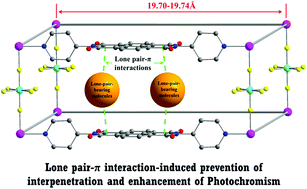Lone pair–π interaction-induced generation of non-interpenetrated and photochromic cuboid 3-D naphthalene diimide coordination networks†
Abstract
Interpenetration is an intrinsic behaviour for the porous coordination networks. To prevent the interpenetration, a common strategy is the imposition of geometric or steric restrictions by incorporating bulky moieties into organic tectons. So far, most of the available incorporations have been achieved through a covalent connection, while few involved in the non-covalent weak interactions. In this paper, we have reported that such interpenetration can be prevented by the less common lone pair–π interactions. By imposing the lone pair–π interactions through the addition of lone-pair-bearing N-methylpyrrolidin-2-one or iodine, combinations of rigid naphthalene diimide tectons bearing two divergently oriented pyridyl units at both imide extremities with ZnSiF6 led to non-interpenetrated cuboid 3-D coordination networks that should have been interpenetrated. In addition, such close-contacting lone pair–π interactions between electron donors and acceptors have also been demonstrated to play a key role in their photochromic properties.


 Please wait while we load your content...
Please wait while we load your content...